Hearns vs Leonard: In Their Own Words
The Sugar Ray Leonard vs Thomas Hearns fight in 1981 was significant for so many reasons. You had two of the best, if not the best, fighters on the planet with the winner to be regarded as the best in all of boxing. Leonard, the reigning WBC welterweight champion, had avenged his only defeat to Roberto Duran in the infamous “No Mas” rematch. Hearns, the WBA welterweight king was unbeaten, scoring 30 knockouts in 32 bouts. They billed this unification match to decide the undisputed welterweight king “The Showdown,” and indeed that’s exactly what it was.
Hearns was three years younger and held a four-inch reach advantage. Leonard was coming off a huge victory over WBA super welterweight titleholder Ayub Kalule to win his second world title. Hearns had made three successful defenses of his crown including stoppage wins over Randy Shields and Pablo Baez since scoring an electrifying two round knockout of the formidable Pipino Cuevas. “The Hitman” had an aura of invincibility and fearsome power, while Sugar Ray was widely viewed as the most talented boxer alive. A “showdown” was inevitable and it was one of the biggest events of the decade.
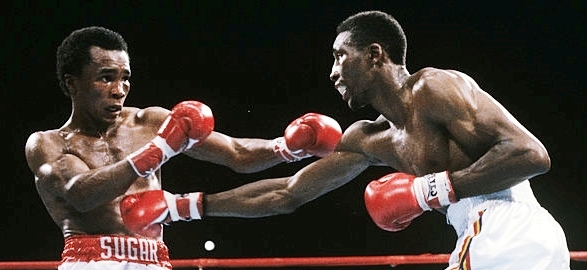
Both Thomas Hearns and Ray Leonard were happy to share with me their memories of that historic match. Even after all these years the recollections of it remain vivid for both men and both expressed mutual respect for their former rival as well as astonishment at how fast the years have gone by since. But despite the passage of time, neither questions the importance of that first meeting for their careers and their legacies.
Despite their public utterances at the time and the posturing for the press, both men had tremendous respect for each other’s talent and ring accomplishments. Leonard was especially impressed with Tommy’s title-winning effort.
“Pipino Cuevas was tough. After watching that fight, I knew Tommy was a killer. I knew I had a real fight on my hands because I saw the power that Tommy had, the punishment he inflicted. It was unbelievable power. He was a beast at 147, an amazing physical specimen.”
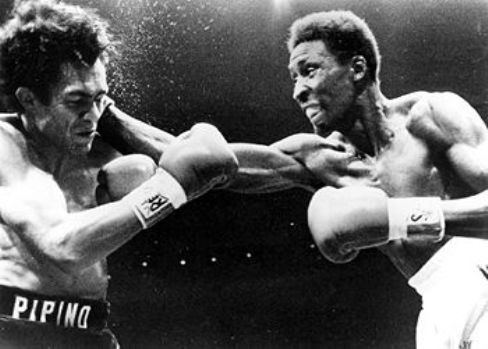
Meanwhile, Hearns knew that he needed perfect mind and body preparation to emerge victorious. “It was great news when I found out I was going to face Ray. To fight Ray Leonard was an honor. He was an Olympic champion, a gold medalist and I knew he was going to have a great career ahead of him. I wanted this fight and wanted to be at my best. I was very positive about the fight, but I felt like the underdog. I felt like people didn’t know enough about me. I felt like I had to go in there and defeat this man.”
A 25 000 seat outdoor arena at Caesars Palace was the venue for the one of the richest matches in boxing history. Ringside seats were $500 and buying them were celebrities like Jack Nicholson, John McEnroe, and Burt Reynolds. Approximately three hundred million people in fifty countries watched Hearns vs Leonard on live closed circuit television or tape delay.
“We were both self-assured and cocky,” recalls Leonard. “The weigh-in was shocking. I weighed in at 146; he weighed in at 145. And it got my attention that he was so light. I looked at him at the weigh-in and said, ‘I’m gonna kick his ass.’”
“Ray tried to get under your skin, to get you crazy,” says Hearns. “I was getting tired of him trying. And really, the way he would say things motivated me.” Afterwards, some wondered if Hearns had been too light and perhaps over-trained, but Tommy sees that as a non-factor. “When I trained, the weight just dropped off me. It was never a struggle to make 147 or any weight. The weight would just drop right off.”
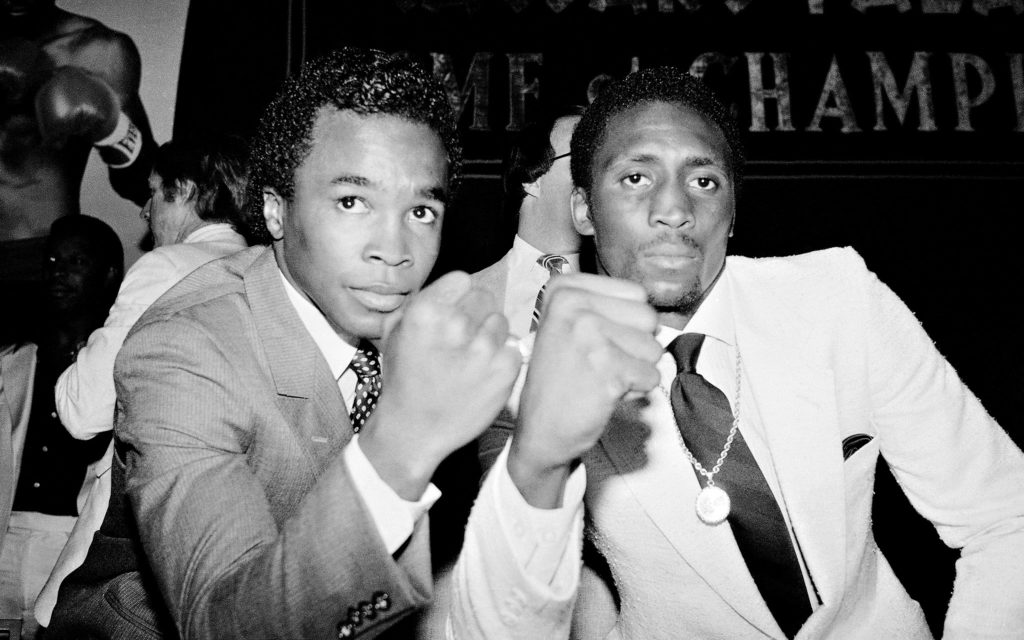
Leonard’s strategy coming into the match was to outbox Hearns, make him uncomfortable, and wear him down. For example, Leonard wanted to get Hearns to move to his left which would force “The Hitman” to exert extra energy in order to get into position to throw his powerful right hand. Since Tommy’s stamina was still a question mark heading into this tilt, Ray wanted to make him work every minute of every round. Ray had intended to test both his opponent’s endurance and his chin.
Meanwhile, Hearns planned on moving forward behind his long left jab to control the flow of the bout. He felt he could outpoint Leonard with the jab and also keep him off balance. The idea was that Ray would have to think about the jab every time he tried to throw shots, which would keep his punch output low. Tommy would then feed off of the jab by following up with right hands and left hooks before Leonard could respond.
The result was a tight and tense tactical contest in the early rounds, neither man having a substantial advantage.
“I was boxing,” says Leonard. “Slipping and sliding. I touched him on the forehead and I said, ‘I got you.’ I knew I would play with him and make him miss. I kept him off balance, but he was so quick, especially with the jab. He was difficult to set up. He was tall and rangy and gifted.”
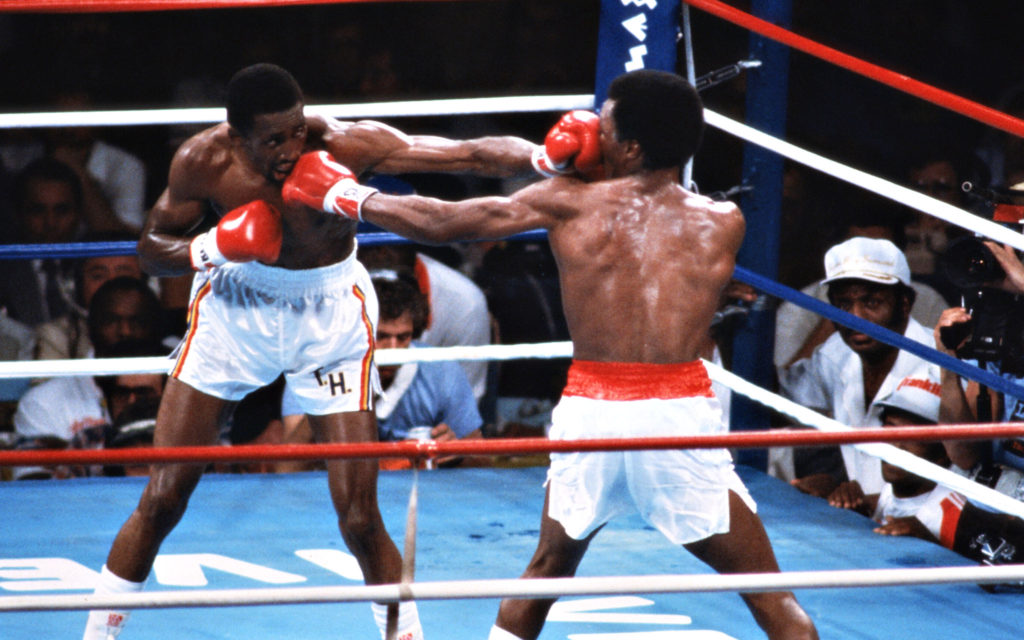
“I was a boxer-puncher in the ring and I mixed it up,” recalls Tommy. “My jab meant a lot to me at the start of the fight. My jab was torture to opponents. When you think about throwing, my jab was in your face. People had trouble getting through to hit me. My jab made me tough to beat.”
All three ringside judges scored all but one of the first five rounds for Hearns. “The Motor City Cobra” was able to land enough of those sharp jabs while largely moving forward to control the distance and tempo of the match. Round four was a great example of this as Hearns landed multiple jabs as well as a hook to the body that got Leonard’s attention. Ray was competitive, but reaching and pawing while his left eye was already beginning to swell. In the fifth Hearns continued to land the jab and Leonard went back to his corner at the end of the round visibly frustrated. However, the momentum was about to shift dramatically in round six.
Leonard landed a right to start off the round, as Hearns snapped home jabs to the body and head. As a confident Hearns moved forward carrying his left hand low, Leonard ducked under a Hearns overhand right and crashed home a powerful left that buckled Tommy’s legs. Ray followed up with a two-fisted assault and Hearns fought back valiantly, but it was Sugar Ray connecting with the punishing blows, most of them left hooks to both body and head. At the bell Tommy’s back was to the ropes and he was holding on to survive. Ray would go on to win the next two rounds and seemingly take full control of the fight.
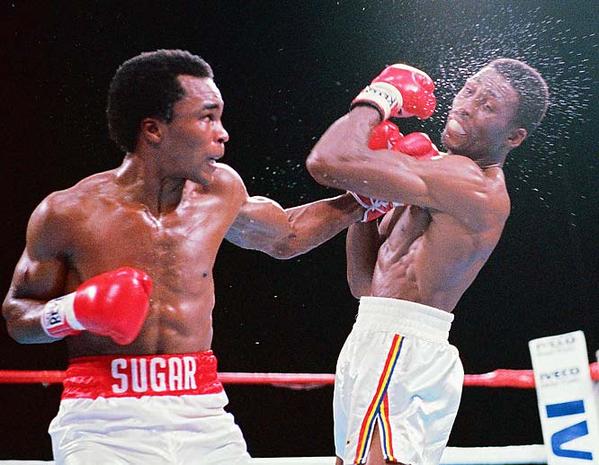
Leonard on hurting Hearns in the sixth: “I hit him with a hook. That changed everything. I remember the fight verbatim and after that, he changed the way he fought. That’s when he showed his boxing ability. He started moving so well. And my left eye was closing, slowly but surely.”
Hearns on the middle rounds: “He caught me with a couple good shots. It was a back and forth fight.”
Following the instructions of his trainer, Emanuel Steward, the boxer they called “The Motor City Cobra” changed his tactics, but according to Hearns this was something they had anticipated might be necessary: “We knew how to adjust during a fight by trying to exploit the other boxer’s vulnerability. We had worked on that so I made the adjustment and was able to come back.”
Starting in round nine, Hearns was effective using the ring and boxing from the outside, connecting with the jab on Leonard’s left eye, as well as landing hooks and right hands to the body. It was another abrupt change in the progression of the bout and suddenly Tommy was the more effective of the two as he won the next four rounds. By the end of round twelve, Hearns appeared in control while Leonard desperately needed to turn things around. Sugar Ray had only three rounds to regain the momentum and he had to dig deep to find a way to do it.
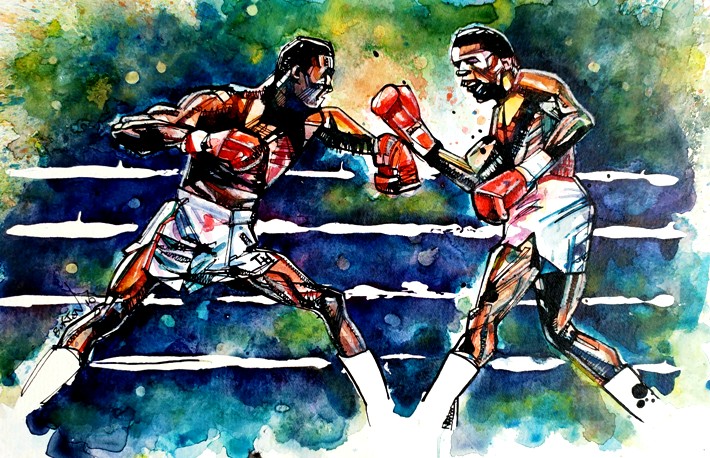
Leonard on what motivated him: “Tommy was landing more punches than I was. Fighters know when they’re losing and I knew he was ahead. I looked for someone I could feed off of and I saw Muhammad Ali at ringside. I used him to inspire me in the fight. Tommy was getting the best out of me but I was getting the best out of him too. I think our ability to rise to the occasion was special.”
As round thirteen began, Leonard’s left eye was almost completely closed. But midway through Ray landed a monster right hand that had Hearns reeling across the ring. Leonard followed up with an extraordinary flurry of rights and lefts that sent Hearns through the ropes, but referee Davey Pearl did not rule it a knockdown and allowed the bout to continue. Tommy managed to score with a right and left, but Ray was walking through his punches now and he landed a series of blows which left Hearns tangled in the ropes once again. Pearl ruled it a knockdown and as the round ended Hearns stumbled back to his corner.
Still behind on the judges’ scorecards, Leonard came out for round fourteen determined to end it. A vicious right hand to the body hurt Hearns and then one to the head put Tommy in a world of trouble. Leonard continued to dominate, landing shots at will until referee Pearl finally stopped the match with Hearns’ back to the ropes. The crowd roared as an exhausted but jubilant Sugar Ray was embraced by his team.
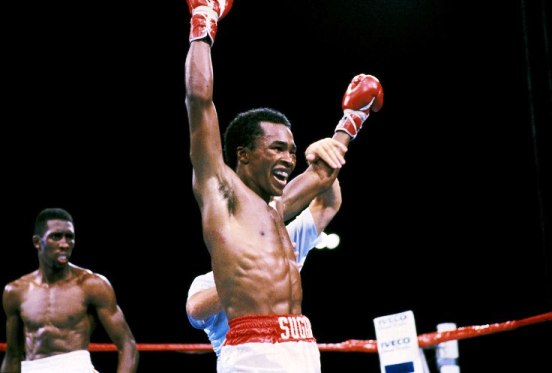
Leonard on the fight’s end: “When I hurt a guy, I go for it. I remember I hit Tommy with a right hand to the body that really affected him. He would fall to the ropes and I just kept going and landing more punches until finally the fight was stopped.”
Hearns on being on the losing end of such a highly anticipated battle: “In the end, he got the better of me. But still, it was one of my best fights. I knew I was part of a great fight as I was fighting it. Ray always got me ready to give all I had. There was going to be some trouble when we fought.”
Leonard and Hearns singled out their respective trainers, Angelo Dundee and Emanuel Steward, and both admitted that their cornermen were instrumental in shaping their careers.
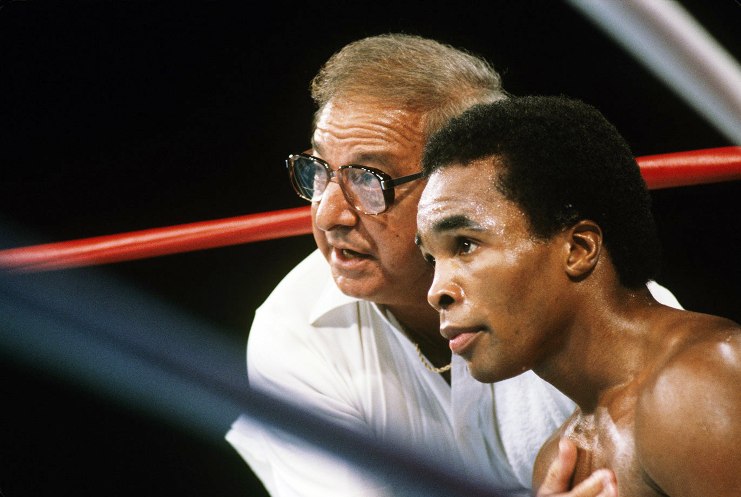
Leonard on Angelo Dundee: “Angelo was calmly telling me during the fight that I had to pick up the pace. He knew exactly how to give me advice. He never yelled or got me over-excited. He knew what to do to put me in the best position to win.”
Hearns on Emanuel Steward: “If there was no Manny Steward, I wouldn’t be the man I am today. Against Leonard the first time, I was pulling out early with my punches. He told me to pull out with my hands held high. I was doing wrong and Manny taught me to do right.”
Their rivalry was a thing of beauty, one that each fighter knew was special. The separation between the two was so minimal that, while both entered the ring with a game plan, neither had a clear sense of what was about to unfold. In 1989 they clashed again, this time for Leonard’s WBC super middleweight belt, and a second action-packed war ended in a controversial draw.
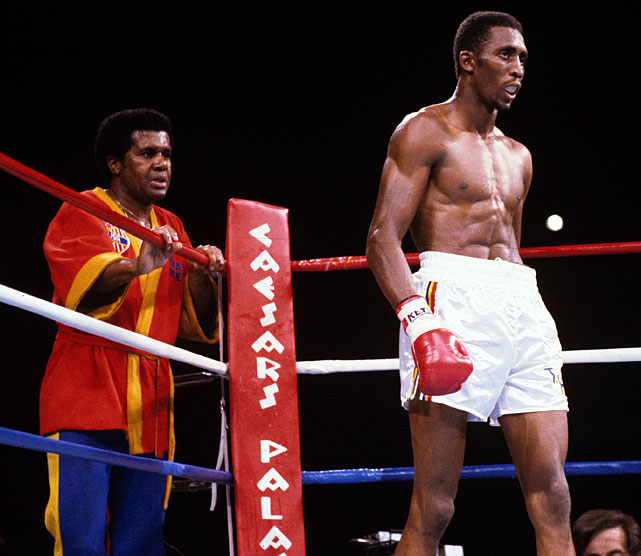
Ring Magazine hailed their first meeting as 1981’s Fight of the Year and in 1996 judged it to be one of the Ten Greatest Fights of All-Time. The bout featured so many dramatic twists and turns and so much suspense that, to this day, it remains one of the all-time best battles in the history of the welterweight division.
“I think of the first fight like what Ali said about Frazier in their last fight,” says Leonard. “He said, ‘It was the closest thing to death I ever experienced.’ I could relate to what Ali went through because it took every ounce of my energy to beat Tommy. Our punches did all the talking. And that kind of fight takes so much out of you.”
“When you get hit by a guy like Tommy Hearns, it’s a question of how great do you want to be. Greatness is when you’re staring at the ropes and you must decide how great you are going to be. Tommy was a monster in the ring. There wouldn’t be a Sugar Ray Leonard if there wasn’t a Thomas Hearns. He was the toughest without question. This was the toughest fight I ever had.”
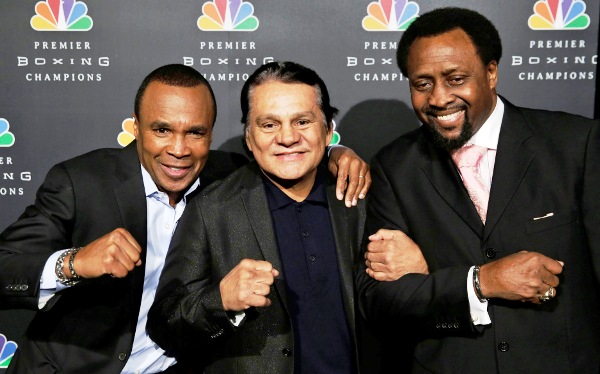
Hearns on making history in his first match with Leonard: “Ray has done very well for the sport. I was very happy that Ray was there, that both of us were there. We respected each other. It was a very special fight. I was blessed to be a part of it. Forever, I am part of this truly great fight.”
Almost four decades later, it remains a very special fight, a truly great fight. — Thad Moore

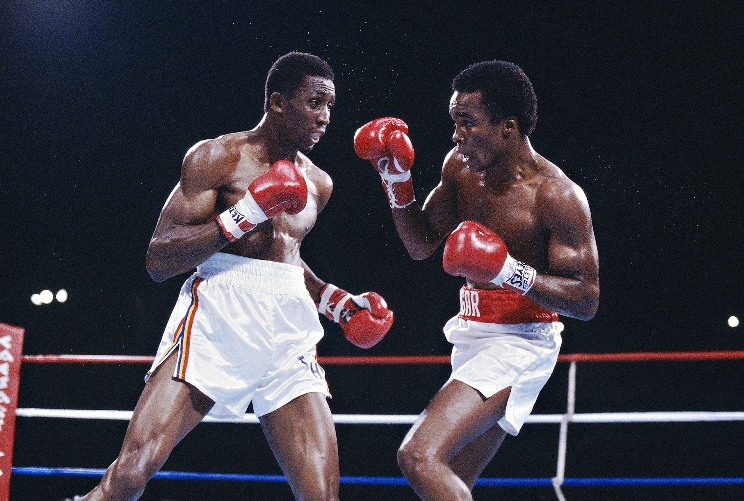

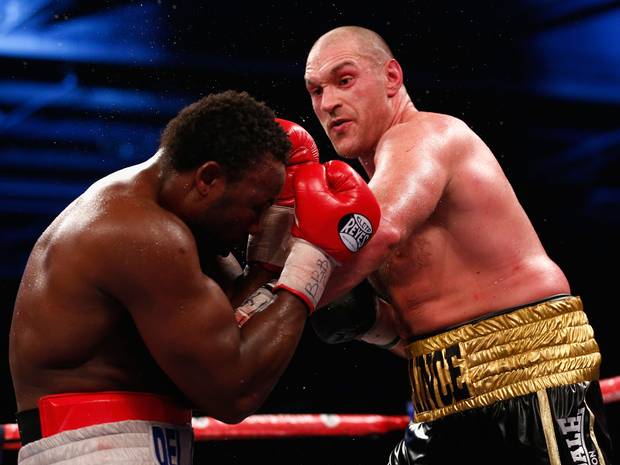

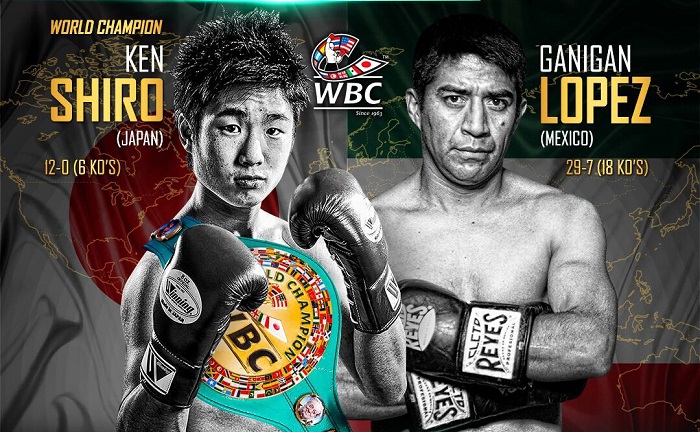
Great article.